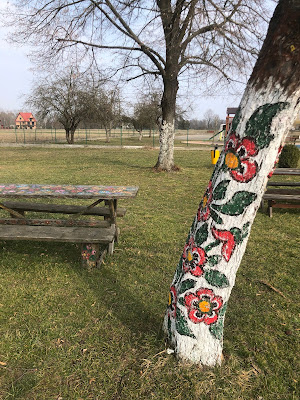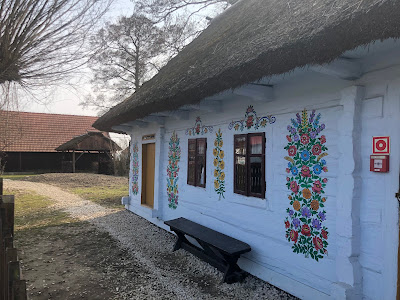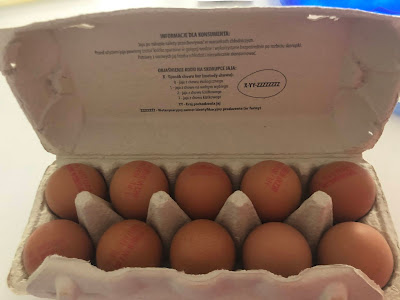I love going grocery shopping—it is my favorite weekly chore! But that's only now that I am familiar with my local stores and know where to find some "speciality" items like popcorn kernels and chocolate chips, even if it means shopping online or going to a specialty store. When we first moved, it was a little overwhelming and anxiety-inducing to make a trip to the grocery store. I even wrote my first Toastmasters speech about it.
Once I learned the pattern of the grocery store, it became fun. I love meandering the aisles and seeing what still sticks out as unusual. Most things I've stopped noticing–eggs in the regular shelving, foil-topped yogurt containers, and unrefrigerated produce–but every so often something still sticks me as either clever or confusing. Rather than my regular format, I think I need to narrate through photos:
Practicalities:
These are the standard carts that are available in most mid-sized grocery stores. In the mega grocery stores (only found inside shopping malls) will you find the full sized carts. Outside of those mega stores, though, aisles are really tiny, and even these two photographed options feel cumbersome in the cramped spaces. Also, I still struggle to smoothly unpack these types of carts at checkout.
Speaking of checkout, this is what it looks like- typically pretty tight with not a whole lot of space to set your stuff down (especially in photo #2). Baggers are not a thing, and it feels like a race trying to bag up your own goods without impeding on the flow of traffic behind you.
A lot of shopping happens in these convenient store-esque shops. I've adapted to going to multiple stores in order to maximize my needs. The small shop like this is my go-to for heavy staples (potatoes, flour, milk) but I got to bigger shops and speciality shops if I want anything semi-interesting.
That's not to say that all stores are teeny-tiny. This is one of the mega mall stores. You can see that there is a lot more space, which also means a lot more variety. Unfortunately going to this store is a 25 minute walk home, so I try to limit my purchase of heavy items.
Produce:
You've probably already seen in some other photographs that produce often is stored in crates or buckets and is often not refrigerated, especially not root vegetables.
This is my favorite mid-sized grocery store, although now I rarely go there since it's also about 25 minutes away from my house. The back wall is the refrigerator produce and the center island is the unrefrigerated produce: fruit, tomatoes, squash. What is funny to me is that lemons will sometimes be chilled and sometimes not and avocados are always refrigerated.
This is my other common store (only about 15 minute walk) but it is a bit chaotic. If feels like boxes are just piled on top of one another and you have to do some digging to find what you want at times.
This is an odd thing to me–some produce is wrapped up in plastic wrap. Broccoli is almost always mummy-wrapped, and you can kind of see that the zucchini is vacuum sealed but the cucumbers are not.
I would consider this as a MASSIVE variety compared to normal. One thing I read was that most produce you find in grocery stores are semi-local, but that also means that the variety significantly decreases during certain times of year. Some things you can always find, though, are carrots, beets, cabbage, and apples.
If you want fresh herbs, you can typically find a small package of dill and parsley, but if you want basil or cilantro you need to buy a living plant.
One of my FAVORITE things is the variety of onion sizes. Most onions are pretty small (about the size of an egg). The thing that I still notice sometimes, though, is that the onion and garlic skins often look spotted with dried dark mold spots.
Dairy & Protein:
Like I said, eggs are never refrigerated, but what is even more peculiar to me is...
...10 eggs per carton. I hate to admit that it was almost a year of living here before I realized that a carton wasn't a dozen eggs.
I'm pretty sure I shared this photo around Christmas, but it is wild to me that they will set up a swimming pool in the grocery store to sell live Christmas carp.
Dairy also surprised me at first. Virtually all dairy comes in plastic cups with foil lids, which makes it hard to re-seal afterwords. I have never seen a container of yogurt larger than the one pictured here (about 500 ml). There is refrigerated milk, but there is more variety in the non-refrigerated UHT (ultra pasteurized) cartons.
I'm not regularly in the meat aisle, but this is a pretty standard set in about half of the stores. However, the other half only have fresh raw meat behind a manned meat counter similar to...
...this one. Clearly this is cheese, but if there is a cheese counter there is a meat counter.
I don't know how interesting this is, but tofu always comes in these vacuum packed squares, and when Cameron gets a meat treat it is often some sort of salami is a pretty loosely-packed plastic or paper sleeve.
Down the Aisle:
Jarred goods are often grouped together, regardless of their contents. Here are pickles, sauces, jams, and other preserved slawed vegetables.
"Bio" is the word for organic. Other than the mega mall stores you often don't see too many bio options.
Even the smallest convenience store type shops will have a bakery section. The bakery goods are delivered, not baked in-store.
My new local grocery store always feels like a bit of a mess. There are multiple walls that seem to be be the excess space for anything that doesn't really fit anywhere else, but you'll never find the same thing there two weeks in a row.
My favorite grocery store does not have a whole lot of variety on much, except for pasta. There is a HUGE aisle that is purely pasta.
Specialty Stores:
If it can't be found in the mega store, it probably can be found in a speciality store. I don't frequent them often, but I have found Indian and Hispanic food shops.
One of my favorite places is an underground high-end goods store. I can't afford most of it, but I often buy specialty sodas for Cameron here when I want to get him a treat.
The underground shop is the only place I know of that sells you live lobster, not that I would ever dare to buy one.
While you can buy alcohol at a standard grocery store, I prefer to buy my beer at a beer-only shop. There are two that I frequent if I want a variety of craft beers.
Of course the best "specialty" shops are markets. There are three that I know of that have outdoor vendors every day, but this one, which is closest to my house, is Saturdays-only (rain or snow or shine).
Other Oddities:
Ice cups. I think this is the only way to buy ice. Take note that on that same shelf there is also frozen raspberries and pierogi. Unlike the US, where frozen food is half of the store, pierogi are often the only frozen pre-made meal you can buy.
Everything comes in bags: pasta, flours, sugar, starch, rice, and salt. I'm sure I've noted this before, but potato starch is your only option here. Another interesting thing is that flour is almost always named after the city it was milled in, and I think the only salt available (unless you are buying pink Himalayan salt) is mined in Poland.
More bags: for a while I could not find cocoa powder and Karob was the closest I could find. Chips and crackers are Cameron's snack of choice, but there aren't a lot of options. A few of the more interesting one's I've found are paprika (which is quite common), ketchups and these ones: mushroom tart.
Ane even more bags: pretzel sticks (I haven't found traditional pretzel shapes), cereal, crackers, and chocolate chips. Chocolate chips are the one thing that we use semi-regularly that I haven't found in a grocery store. Occasionally I'll buy a bag online, but more often I'll just buy a chocolate bar and break it up.
Now for our vices. You can buy M&Ms but I've only found them in the mega stores and they are SUPER expensive (this bag costs the equivalent of ~$10). As far as alcohol, it is pretty cheap. The Soplica brand is very common for flavored liquors, vodka is the standard here, and I love this brand of Georgian wine. One thing I find interesting is that all alcohol has the paper seal over top that you can see on the wine bottle.
Tomato sauce only comes in boxes, and most cans are peel tops. On the rare occasion where I have bought a can that requires a can opener, we've had to stab at it with a knife since our apartment didn't come with that particular appliance.
And lastly spices and baking. Spices come in these little packets, which is kind of nice since we are able to use their contents before they go stale. You can't find liquid broth, so we always keep some mushroom or vegetable bullion cubes for the times we don't have homemade broth available. Pure vanilla extract is the other thing we haven't found, so we end up with these tiny bottles of vanilla syrup. Lastly, baking solids (soda, powder, and gelatin) are also in little envelopes.
Well, I hope this was a little fun to see. As one of my friends says, grocery stores are the best way to see that you are in a different country. The same friend also has been shocked by the things we lack. I was on the phone with here one morning (our common call time is 7am my time, 11pm her time) and contemplating what I should have for breakfast. She suggested picking up a canister of Pillsbury cinnamon roles, and I laughed because that is definitely not something you would ever find in a Polish grocery store.






























































